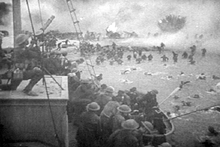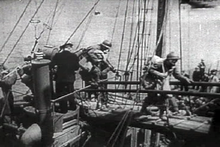
The Maginot Line, named after the French Minister of War André Maginot, is a line of concrete fortifications, obstacles and weapon installations built by France in the 1930s to deter invasion by Nazi Germany and force them to move around the fortifications. It was impervious to most forms of attack; consequently, the Germans invaded through the Low Countries in 1940, passing it to the north. The line, which was supposed to be fully extended further towards the west to avoid such an occurrence, was finally scaled back in response to demands from Belgium. Indeed, Belgium feared it would be sacrificed in the event of another German invasion. The line has since become a metaphor for expensive efforts that offer a false sense of security.

Nazi Germany, officially known as the German Reich and later the Greater German Reich, is a term used to describe the German state between 1933 and 1945, when Adolf Hitler and the Nazi Party controlled the country, transforming it into a totalitarian dictatorship. The Third Reich, meaning "Third Realm" or "Third Empire", referred to the Nazi claim that Nazi Germany was the successor to the earlier Holy Roman Empire (800–1806) and German Empire (1871–1918). The Third Reich, which the Nazis referred to as the Thousand-Year Reich, ended in May 1945, after only 12 years, when the Allies defeated Germany and entered the capital, Berlin, ending World War II in Europe.

Why We Fight is a series of seven propaganda films produced by the US Department of War from 1942 to 1945, during World War II. It was originally written for American soldiers to help them understand why the United States was involved in the war, but US President Franklin Roosevelt ordered distribution for public viewing.

The Atlantic Wall was an extensive system of coastal defences and fortifications built by Nazi Germany between 1942 and 1944 along the coast of continental Europe and Scandinavia as a defence against an anticipated Allied invasion of Nazi-occupied Europe from the United Kingdom, during World War II. The manning and operation of the Atlantic Wall was administratively overseen by the German Army, with some support from Luftwaffe ground forces. The Kriegsmarine maintained a separate coastal defence network, organised into a number of sea defence zones.
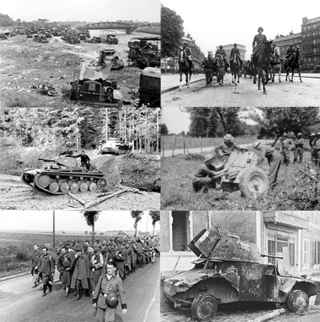
The Battle of France, also known as the Western Campaign, the French Campaign and the Fall of France, during the Second World War, was the German invasion of France, that notably introduced tactics that are still used. France and the Low Countries were conquered, ending land operations on the Western Front until the Normandy landings on 6 June 1944.
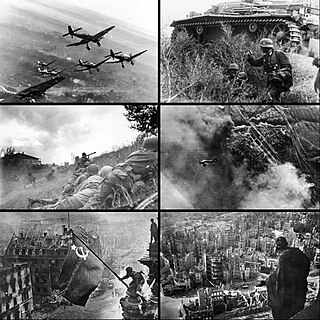
The European theatre of World War II was one of the two main theatres of combat during World War II. It saw heavy fighting across Europe for almost six years, starting with Germany's invasion of Poland on 1 September 1939 and ending with the Western Allies conquering most of Western Europe, the Soviet Union conquering most of Eastern Europe including the German capital Berlin, and Germany's unconditional surrender on 8 May 1945 although fighting continued elsewhere in Europe until 25 May. On 5 June 1945, the Berlin Declaration proclaiming the unconditional surrender of Germany to the four victorious powers was signed. The Allied powers fought the Axis powers on two major fronts, but there were other fronts varying in scale from the Italian campaign, to the Polish Campaign, as well as in a strategic bombing offensive and in the adjoining Mediterranean and Middle East theatre.
The events preceding World War II in Europe are closely tied to the bellicosity of Fascist Italy, Nazi Germany, and Imperial Japan, as well as the Great Depression. The peace movement led to appeasement and disarmament.

The Western Front was a military theatre of World War II encompassing Denmark, Norway, Luxembourg, Belgium, the Netherlands, the United Kingdom, France, and Germany. The Italian front is considered a separate but related theatre. The Western Front's 1944–1945 phase was officially deemed the European Theater by the United States, whereas Italy fell under the Mediterranean Theater along with North Africa. The Western Front was marked by two phases of large-scale combat operations. The first phase saw the capitulation of Luxembourg, Netherlands, Belgium, and France during May and June 1940 after their defeat in the Low Countries and the northern half of France, and continued into an air war between Germany and Britain that climaxed with the Battle of Britain. The second phase consisted of large-scale ground combat, which began in June 1944 with the Allied landings in Normandy and continued until the defeat of Germany in May 1945 with its invasion.
SS-Verfügungstruppe was formed in 1934 as combat troops for the Nazi Party (NSDAP). On 17 August 1938 Adolf Hitler decreed that the SS-VT was neither a part of the Ordnungspolizei nor the Wehrmacht, but military-trained men at the disposal of the Führer. In time of war, the SS-VT were to be placed at the disposal of the army.
The Timeline of the Battle of France, also known as the Fall of France, covers the period during World War II from the first military actions between Germany and France and to the armistice signed by France. Over the period of six weeks, from May 10 to June 25, 1940, Nazi Germany had also conquered Belgium, Netherlands and Luxembourg. Nazi Germany's overall plan was to invade the Low Countries which would make the French and British troops leave their current position and position their forces in Belgium. Then, a second force would navigate through the Ardennes Forest and move around the Maginot Line at the weakest part of the Allied defences. The force would then move towards the west French coast and cut the northern Allied force off. The Germans would then capture Paris, eliminate any resistance that remained, cross the English Channel, and invade the United Kingdom.
The New Order of Europe was the political and social system that Nazi Germany wanted to impose on the areas of Europe that it conquered and occupied.
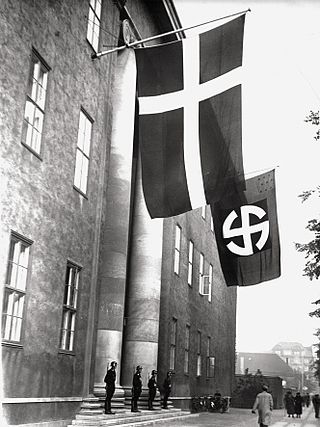
The Germanic SS was the collective name given to paramilitary and political organisations established in parts of German-occupied Europe between 1939 and 1945 under the auspices of the Schutzstaffel (SS). The units were modeled on the Allgemeine SS in Nazi Germany and established in Belgium, Denmark, the Netherlands, and Norway—population groups who were considered to be especially "racially suitable" by the Nazis. They typically served as local security police augmenting German units of the Gestapo, Sicherheitsdienst (SD), and other departments of the German Reich Security Main Office (RSHA), rendering them culpable for their participation in Nazi atrocities.

The propaganda used by the German Nazi Party in the years leading up to and during Adolf Hitler's dictatorship of Germany from 1933 to 1945 was a crucial instrument for acquiring and maintaining power, and for the implementation of Nazi policies.

The Nazis Strike is the second film of Frank Capra's Why We Fight propaganda film series. Released in 1943, it introduces Germany as a nation whose aggressive ambitions began in 1863 with Otto von Bismarck and the Nazis as its latest incarnation.

The Gaue were the main administrative divisions of Nazi Germany from 1934 to 1945.

The Manstein Plan or Case Yellow, was the war plan of the German armed forces for the Battle of France in 1940. The original invasion plan was an awkward compromise devised by General Franz Halder, the chief of staff of Oberkommando des Heeres that satisfied no one. Documents with details of the plan fell into Belgian hands during the Mechelen incident on 10 January 1940 and the plan was revised several times, each giving more emphasis to an attack by Army Group A through the Ardennes, which progressively reduced the offensive by Army Group B through the Low Countries to a diversion.

Operation Weserübung was the invasion of Denmark and Norway by Nazi Germany during the Second World War and the opening operation of the Norwegian Campaign.

The Greater Germanic Reich, fully styled the Greater Germanic Reich of the German Nation, was the official state name of the political entity that Nazi Germany tried to establish in Europe during World War II. The territorial claims for the Greater Germanic Reich fluctuated over time. As early as the autumn of 1933, Adolf Hitler envisioned annexing such territories as Bohemia, western Poland and Austria to Germany and the formation of satellite or puppet states without independent economies or policies of their own.

During the Second World War, Pope Pius XII maintained links to the German resistance to Nazism against Adolf Hitler's Nazi regime. Although remaining publicly neutral, Pius advised the British in 1940 of the readiness of certain German generals to overthrow Hitler if they could be assured of an honourable peace, offered assistance to the German resistance in the event of a coup, and warned the Allies of the planned German invasion of the Low Countries in 1940. The Nazis considered that the Pope had engaged in acts equivalent to espionage.

The historiography of the Battle of France describes how the German victory over French and British forces in the Battle of France had been explained by historians and others. Many people in 1940 found the fall of France unexpected and earth shaking. Alexander notes that Belgium and the Netherlands fell to the German army in a matter of days and the British were soon driven back to the British Isles,
But it was France's downfall that stunned the watching world. The shock was all the greater because the trauma was not limited to a catastrophic and deeply embarrassing defeat of her military forces – it also involved the unleashing of a conservative political revolution that, on 10 July 1940, interred the Third Republic and replaced it with the authoritarian, collaborationist Etat Français of Vichy. All this was so deeply disorienting because France had been regarded as a great power....The collapse of France, however, was a different case.
